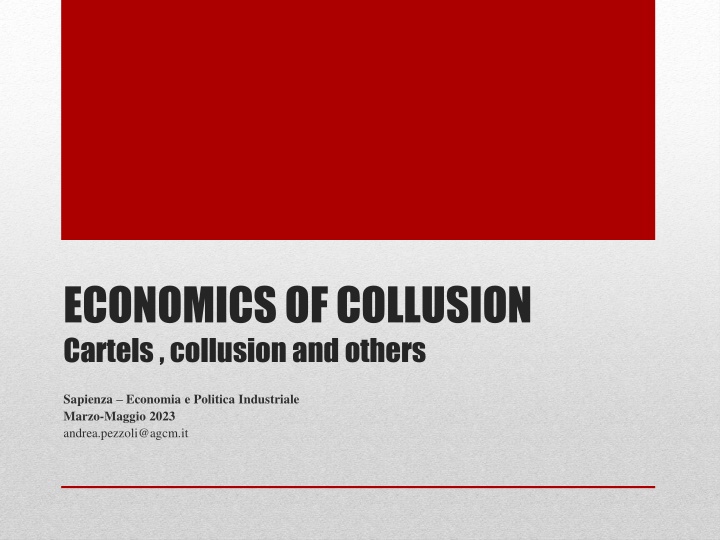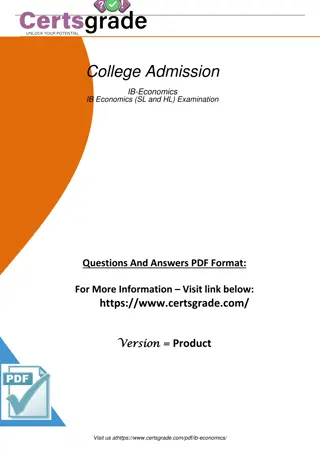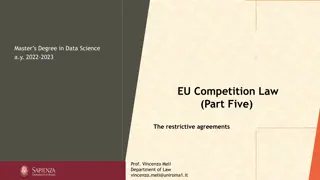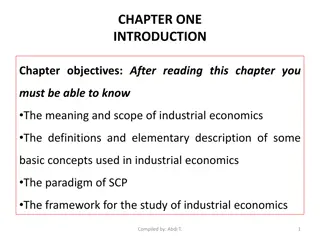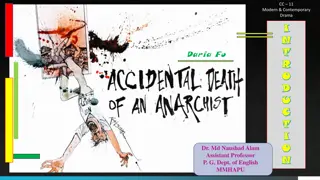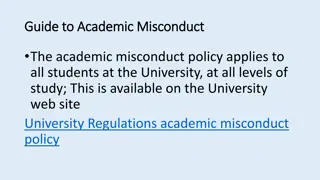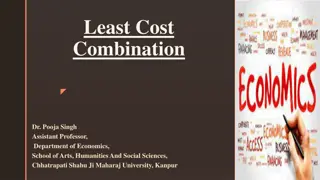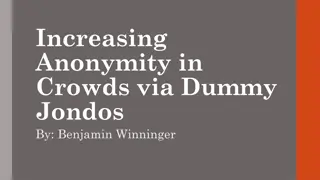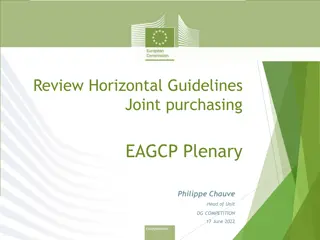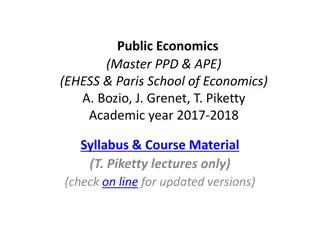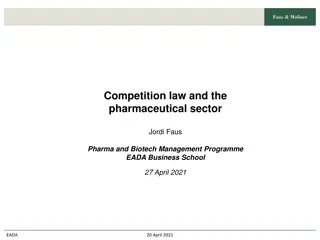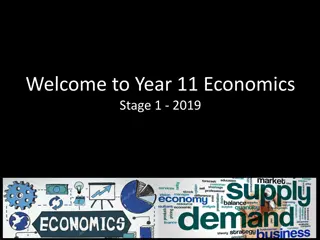ECONOMICS OF COLLUSION
In this article, the focus is on the economics of collusion, cartels, and practices related to antitrust laws. Discussions revolve around consumer welfare, efficiency, protection of competitive processes, and the detrimental effects of cartels within various economic approaches. The article delves into the assessment of cartels, detection, deterrence, stability, and the implications of horizontal agreements. Key concepts such as explicit and tacit collusion, relevant markets, and the distinction between restrictive agreements and hard-core cartels are also explored.
Download Presentation

Please find below an Image/Link to download the presentation.
The content on the website is provided AS IS for your information and personal use only. It may not be sold, licensed, or shared on other websites without obtaining consent from the author.If you encounter any issues during the download, it is possible that the publisher has removed the file from their server.
You are allowed to download the files provided on this website for personal or commercial use, subject to the condition that they are used lawfully. All files are the property of their respective owners.
The content on the website is provided AS IS for your information and personal use only. It may not be sold, licensed, or shared on other websites without obtaining consent from the author.
E N D
Presentation Transcript
ECONOMICS OF COLLUSION Cartels , collusion and others Sapienza Economia e Politica Industriale Marzo-Maggio 2023 andrea.pezzoli@agcm.it
SOME PRELIMINARY REMARKS TO KEEP IN MIND Consumer welfare standard vs the protection of the competitive process Efficiency as the sole goal of antitrust vs multiple goals Does the economic approach efficiency What about economic efficiency? Antitrust protects competition, not competitors Rather than competition the consumer welfare standard protects the outcome of past competition focus solely on freedom and dynamic 2
Cartels, Practices Thecontributionofeconomicanalysis Horizontal agreements, Concerted One of the few issues where we register a wide agreement among the the different economic approaches Collusion is universally disapproved! A wide consensus from Chicago to Hipster antitrust: cartels are the worst of the possible antitrust sins!!! Whatever the efficiency concept, cartels are bad Definition of relevant markets? Does the definition of relevant market matter in the assessment of cartels? The thin line between explicit and implicit collusion Cartels screening (not to find the thief but to understand if there might be a crime) 3
Cartels, Horizontal agreements, Concerted Practices People of the same trade seldom meet together, even for merriment and diversion, but the conversation ends in a conspiracy against the public, or in some contrivance to raise price (Adam Smith, 1776) 4
Cartels, Practices: Key words Horizontal Agreements, Concerted Detection Deterrence Stability Deviation Maverick Retaliation Leniency Whistleblowing Settlements Compliance Programs Exchange of minds vs. Intelligent and Unilateral Adjustment 5
Cartels, Horizontal agreements, Concerted Practices Not all horizontal agreements are restrictive agreements Hard core cartels (illegal per se) and horizontal agreements By object vs by effect: clear dichotomy or moving boundaries? By object does not mean per se Explicit and tacit (implicit) collusion: not only a semantical issue 6
Where Do We Find Cartels? Economic Analysis andCartelsScreening Cartels are easier to sustain in: 1. Concentrated industry 2. With a small number of suppliers 3. Similar cost structures 4. Homogeneus goods or services, 5. Stable and inelastic demand, 6. Limited technological change 7. High degree of transparency But even in fragmented and mature industries cartels may be seen as a defensive reply to the risk of declining as a surrogate of an ineffective welfare policy 7
Hardcore cartels Chicago (Bork) and a narrow definition of hardcore cartels: only naked cartels should be illegal per se (i.e. only when cartels are not ancillary to cooperative productive activities engaged by the parties): even price fixing, market sharing or other ways aimed at eliminating rivalry) should be judged according the standards applicable to horizontal mergers!! 8
Hardcore cartels and restrictions by object In EU Competition Law the concept of per se does not exist Some horizontal agreements may fall within the restrictions by object : price-fixing, market sharing; exchanging information which reduces uncertainty about future behaviour; market sharing; limiting output (including the removal of excess capacity); limiting sales; collective exclusive dealings; paying competitors for delaying le launch of competing products (Whish and Bailey, 2015) 9
Hardcore cartels and restrictions by object What does byobject mean? Is economic analysis still useful? How? The counterfactual What if 10
Restrictions by object (can we fully ignore the effect?) Even agreements classed as by object restrictions may achieve efficiency benefits? The dichotomy between object and effect is not so clear-cut Considering economic effects under the object assessment is not cast as a balance to any restrictive effects, but rather as an assessment of whether the agreement restricts competition in the first place It is generally necessary to assess the content of the agreement; the objectives it seeks to attain; the economic and legal context of which it forms part 11
Cartes Bancaires (2014) In 1984 in France the groupementdescartesbancaires (CB) was created so that the holders of payment cards issued by a member of CB could make payments to affiliated merchants and withdrawals from cash machines operated by members Pricing (or fee transfers) arrangements were agreed between members European Commission concluded that the pricing measures adopted by CB were an infringement by object and effect (2007) On appeal the General Court supported the decision but only restrictions by object no need to examine the effects The ECJ overturned this ruling: the concept of by object can be applied only to certain types of coordination between undertakings which reveal a sufficient harm to competition that it may be found that there is no need to examine their effects (2014) 12
Concerted Practices, betweenexplicitand tacit collusion We just observe a peculiar parallelism (anomalies) in the market (endogenous element) and we have to prove if it is the consequence of a restrictive agreement or of a rational, unilateral adjustment We need also evidence of qualified contacts (exogenous element) otherwise Antitrust agencies have to prove that the anomalies cannot be explained but with the existence of a cartel! The conditions under which collusion is likely to be sustained do not differ much between tacit and explicit collusion Tacit collusion is not a violation of competition law. We can cope with it only with merger review (dealing with coordinated effects and with market collusion collective dominance ) structure which facilitates 13
Algorithms and Collusion Pricing algorithms can make cartels more stable Can facilitate collusion But what if they just make unilateral and independent adjustments faster and more intelligent? And what if pricing decisions are no more taken by human beings but deep learning algorithms (i.e. robots) 14
Exchanges of Information How frequent? What s the degree of disaggregation? How sensitive the information and the data? Historical, present or future data? Can the information be found in the public domain? Which is the context in which the exchange of information takes place Horizontal (between competitors) and Vertical (between firms and consumers) transparency Public Announcements 16
Exchanges of Information: Bananas(2013) again!! Chiquita, Dole and Weichert between 2000 and 2002 exchanged weekly information on prices and volumes in advance of agreeing contracts with costumers in northern Europe Bilateral pre-pricing communications prior to setting their quatations (volumes, price trends, market information and likely future quatation prices ) Actual prices (not directly linked to the shared quatation prices) were agreed with costumers in weekly negotiations (and took into consideration their different barganaing power) but without the veal of ignorance that is the salt of competition!! (see on this point, Harrington) In 2013 the General Court stated that it was a by object infringement (Del Monte and Dole v. Commission, 14 March 2013) 17
A Vertical Expression of Two Horizontal Desires:Hub &Spoke 18
A Vertical Expression of Two Horizontal Desires: Hub &Spoke Indirect communicating via costumers or suppliers information exchange: England replica shirt and European Footbsll Championship 2000 Umbro JJB Sports-----------Sports Soccer 19
Beyond Restrictive Agreements Pros and Cons of Joint Purchasing (i.e. Supermarkets and purchasing alliances) and Selling (e.g. Joint selling of Sport Rights) R&D and licensing agreements Settlement agreements in the Pharma industry: dispute between originators and generics over the validity of the branded company s patents: they can settle reverse payment (or pay for delay) in exchange of dropping the litigation If the generic decides to litigate in the absence of a settlement; if the litigation is resolved before the patent expiry date; if the genneric firm wins the litigation, banning settlement agreement may facilitate entry When the settlement values are large and linked to the generic s forgone profits Economic incentives regarding R&D in innovative markets are complex an effects based approach would be more appropriate . 20
A recap 1. Hardcore or per se restrictions 2. Quick look 3. Deeper look 4. Potential effect 5. Actual effect By object (1-3 or even 1-4) By effect (4-5) 21
Restrictions by object and efficiency benefits Assessing the efficiency benefits under art. 101(3) and see if they outweigh any restrictive effects identified under art. 101(1) Four conditions: i) improvement of the production or distribution of goods or promotion of technical or economic progress; ii) consumers must receive a fair share of the resulting benefits; iii) inclusion of the restrictions that are indispensable to the attainment of these objectives (i.e. proportionality test); iv ) competition shouldn t be eliminated in a substantial part of the market 22
Leniency Programs and Cartel Stability Leniency as a crucial tool for detection! and to threaten cartel stability Deterrence: Cartel s profits vs. probability to be detected times the amount of fine In Spain 2008, queues of applicants outside the offices of the Spanish Authority... In Italy too, in recent years the number of leniency applicants has significantly increased Incentive theory at work: reaping the benefits of a cartel for many years and the confessing in time for immunity!! A proportion of the fine (up to 100% for the first applicant) will be waved What about private enforcement and criminal implications? 23
SustainableAgreements Competition and Sustainability are not at odds Trade-off between competition and sustainability How deal with collective and/or inter-generational benefits? What about the second requirement for the application of art. 101 (3)? More antitrust? generally, what about public interests and 24
ECONOMICS OF COLLUSION (?) Verticals Luiss - 1 October 2021 andrea.pezzoli@agcm.it
Vertical Restrictions? Restraints and or Vertical Vertical restraints are generally less harmul than horizontal restraints The alignement of the interests of sellers and buyers aimed at promoting high quality, high volumes, low retail prices Resale Price Maintenence (RPM) and Exclusive Territories Intra and Inter-brand competition 26
Vertical Restrictions? Restraints and or Vertical Unlikely competitive assessment of verticals market definition plays a crucial role horizontal agreements in the Verticals, efficiency and the protection of the competitive process: Chicago, post-Chicago and the return of the structuralist approach 27
Vertical Restrictions? Restraints and or Vertical Apple and 5 major publishers: matching any retail price for e-books that was offered by other book retailers The leading manufacturer of false teeth in US refused to supply its products to independent dealers if they sold competing dentures The French maker of wedding dresses granted its frenchisees in Germany esclusive territories but did not allow them to open new shops or sell competing wedding dresses In 1992 VW did not allow Italian dealers to sell cars to people leaving outside Italy (parallel trade) 28
Economicrationalesforverticalrestraints Coase, Posner, Williamson and the transaction costs The goal of a manufacturer is generally to encourage its distributors to increase sales: agreements which provide low retail prices and high quality distribution (e..g. pre and post sales services) Principal-Agent theory and the alignement of incentives 29
Economicrationalesforverticalrestraints The problem of double marginalization The manufacturers; ii) other distributors free riding problems: i) other The hold up problem: relationship-specific investements 30
The problem of double marginalization Worse than a monopolist? A succession of monopolists Vertical agreements can overcome the multiple marginalization problem The most complete form of vertical coordination is vertical integration 31
Thefreeridingproblems The typical problem of externality: I make an effort which benefits another party (e.g. my rival) that does not contribute to the effort!! Vertical restraints as a mean to internalize externalities 32
The manufacturers free riding problems: other A manufacturer invests in the distribution channel to promote the sales of its products. Rival producers use the same outlets without contributing to the investment (e.g. Unilever and freezer cabinets free of charge ) Exclusive dealing? Minimum percentage of the retailers sale? 33
Thefreeridingproblems:otherdistributors A manufacturer may want its dealers to provide pre and post-sales services to consumers (e.g. particularly important for experience maintenaince/spare parts) goods and for Exclusive territory, RPM? Any discounting by free riders would be ruled out What about on line sales ? 34
The hold up problem: relationship-specific investements A low cost airline company encourages an under utilized regional airport to develop and grow The Airport needs to invest (terminals, handling facilities ); the airline commits to base a minimum number of aircraft It requires some guarantees that the airline is indeed going to use the airport (exclusive dealing, the airline agrees to not fly from rival airports reasonable duration for the exclusivity ) The investments are highly specific to reassure the airline the airport guarantees substantial discounts 35
Other distribution efficiencies and vertical restraints Economies of scale in distribution and reduction in the number of the dealers (exclusive territory) Incentive to promote the product (particulary important for a new entrant in a new geographic market) Optimal stock levels Protection of producer s brand and reputation: selective distribution Vertical agreements as a bargaining outcome (e.g. relations between major supermarkets and their suppliers ) 36
Foreclosure effects of vertical restraints: Marketdefinitionmatters Vertical restraint or abuse of dominance (Unilever and the ice cream market ) Networks of agreements. Forclosure and market power under art. 101 (1) is generally less than the degree required for finding a dominance under art. 102 From an economic perspective if the foreclosure is the concern, the same criteria should apply Minimum efficient size for the new entrant and the possibility to discipline the incumbent 37
Hardocoreverticalrestraints:RPM? Cartels eliminate inter-brand competition; RPM eliminates only intra-brand competition Yet competition law has generally treated RPM with hostility until very recently (hardcore restriction?) In EU RPM agreements cannot qualify for a block exemption (an exemption may be granted under art. 101 (3), on a case by case basis ) RPM as a facilitator for horizontal collusion among suppliers or distributors (do you remember Hub &Spoke?) 38
Hardcore Territories vertical restraints: Exclusive Exclusive territory clause and parallel trade and the objective in the EU Treaty to create a Single Market In the 90 s in Italy prices of VW were 20- 30% lower, because of the exchange rate Was VW entitled to protect its German dealers? 39
Vertical Restraints in Online and Digital Markets Selective Distribution (Pierre Fabre and Coty ) Most Favoured Nation-clauses (Booking/Expedia ) The Apple e-books case (again MFN): was the agency agreement the only way Apple could have entered the market? And Apple entry broke down Amazon monopoly? MFN can facilitate horizontal collusion (among publishers) but assessing vertical restraints in dynamic markets such as e-book is a very difficult task!! Apple/Amazon and dual distribution: an anticipation of the VBER 40
